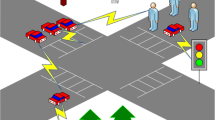Abstract
Identification of different driving fatigue levels is critical for driving fatigue prediction and prevention, which will also promote the research and application of related driving assistance system. Although the driver’s subjective fatigue feeling can be directly obtained by questionnaires, it varies a lot among different drivers and definition of unusual fatigue levels are sometimes arbitrarily determined. In order to get a relatively objective driver fatigue evaluation criterion, this study adopts a novel method which combines subjective fatigue level evaluation method (KSS) with driver face state video recognition technology to assess driver’s fatigue level. Based on the analysis results, a new model was used to obtain the threshold value of driver fatigue levels, and the evaluation criteria of fatigue levels were established based on driver face state video recognition technology. And it is found that this method is more precise than that based on PERCLOS only.
Access this chapter
Tax calculation will be finalised at checkout
Purchases are for personal use only
Similar content being viewed by others
References
Vanlaar, W., Simpson, H., Mayhew, D., Robertson, R.: Fatigued and drowsy driving: a survey of attitudes, opinions and behaviors. J. Saf. Res. 39(3), 303–309 (2008)
Zhang, G., Yau, K.K.W., Zhang, X., et al.: Traffic accidents involving fatigue driving and their extent of casualties. Accid. Anal. Prev. 87, 34–42 (2016)
Elzohairy, Y.: Fatal and injury fatigue-related crashes on Ontario’s roads: a 5-year review. In: Highway Safety Roundtable and Fatigue Impairment, Driver Fatigue Symposium, Toronto, May 16th 2007
MacLean, A.W., Davies, D.R., Thiele, K.: The hazards and prevention of driving while sleepy. Sleep Med. Rev. 7(6), 507–521 (2003)
Fernandes, R., Hatfield, J., Job, R.S.: A Systematic investigation of the differential predictors for speeding, drink-driving, driving while fatigued, and not wearing a seat belt, among young drivers. Transp. Res. Part F Traffic Psychol. Behav. 13(3), 179–196 (2010)
Fell, D.L., Black, B.: Driver fatigue in the city. Accid. Anal. Prev. 79(4), 463–469 (1997)
Williamson,A.M., Feyer, A.M., Friswell, R.: The impact of work practices on fatigue in long distance truck drivers. Accid. Anal. Prev. 28(6), 709–719 (1996)
Hattori, H., Matsuura, Y., Nammiya, K., et al.: Fatigue and fatigue research: the Australian experience (1987). Paper Presented to 7th Biennial Australasian Traffic Education Conference, Speed, Alcohol, Fatigue, Effects. Brisbane (Feb 1998)
Xu, L., Li, S., Bian, K., et al.: Sober-drive: A Smartphone-Assisted Drowsy Driving Detection System. In: Proceedings of 2014 International Conference on Computing, Networking and Communications, pp. 398–402 (2014)
Yin, Y.: Research on driver fatigue state based on analyzing EEG and eye blink in stimulated driving environment. Tongji university master’s degree thesis, (2008)
Singh, H., Bhatia, J.S., Kaur, J.: Eye tracking based driver fatigue monitoring and warning system. In: India International Conference on Power Electronics, IICPE (2010)
Adachi, K., Itoh, M., Mori, S., et al.: A driving simulator with driver monitor system. Reports of the Faculty of Science and Technology, Meijo University vol. 45, pp. 63–9 (2005)
Pfurtscheller, G., Aranibar, A.: Event-related cortical desynchronization detected by power measurements of scalp EEG. Electroencephalogr. Clin Neurophysiol. 42(6), 817–826 (1977)
Acknowledgments
This research was jointly sponsored by Project 51578417 supported by the National Natural Science Foundation of China and the Fundamental Research Funds for the Central Universities.
Author information
Authors and Affiliations
Corresponding author
Editor information
Editors and Affiliations
Rights and permissions
Copyright information
© 2017 Springer International Publishing Switzerland
About this paper
Cite this paper
Wu, G. et al. (2017). Fatigue Driving Influence Research and Assessment. In: Stanton, N., Landry, S., Di Bucchianico, G., Vallicelli, A. (eds) Advances in Human Aspects of Transportation. Advances in Intelligent Systems and Computing, vol 484. Springer, Cham. https://doi.org/10.1007/978-3-319-41682-3_57
Download citation
DOI: https://doi.org/10.1007/978-3-319-41682-3_57
Published:
Publisher Name: Springer, Cham
Print ISBN: 978-3-319-41681-6
Online ISBN: 978-3-319-41682-3
eBook Packages: EngineeringEngineering (R0)




